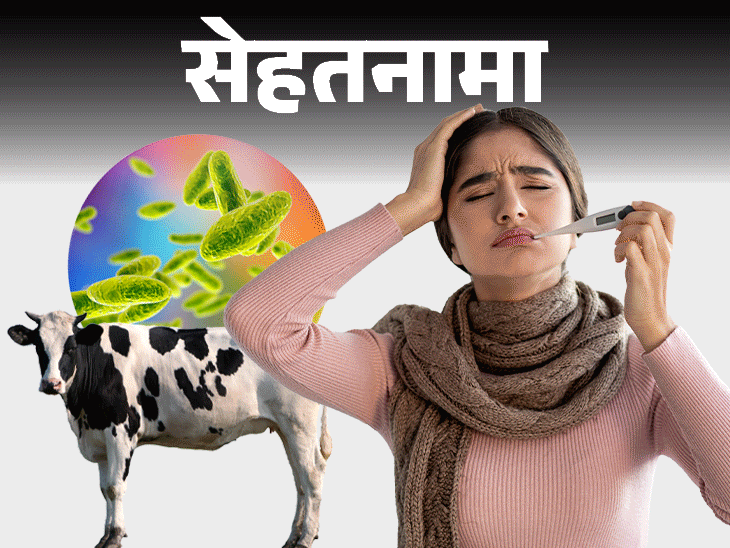12 minutes agoAuthor: Gaurav Tiwari
- copy link

India has almost overcome the biggest health crisis of the present time, Covid-19. However, the year 2024 has not been very good for Gujarat so far. At the beginning of the year, people of the state were troubled by mumps. Currently, cases of Chandipura virus are increasing. According to a recent study, there is a risk of avian flu and brucellosis (Malta fever).
According to a study by the Centre for One Health Education, Research and Development, the state is more susceptible to diseases that spread from birds and animals to humans. This means that the climate and conditions in Gujarat are such that people here are at a higher risk of diseases like Malta fever than in other states.
Every year around 5 lakh cases of Malta fever are reported all over the world. This can cause joint pain. If there is already joint pain then this problem can increase. Apart from this, problems related to heart, liver and brain can also increase.
so today ‘health report‘ We will talk about Malta fever. Along with this, we will know that-
- What is Malta Fever?
- What are its symptoms and how does it spread?
- What is its treatment and prevention?
What is Malta Fever?
It is a zoonotic disease. This means that it spreads to humans through animals. It is known by many names such as brucellosis, undulant fever, Malta fever and Mediterranean fever. This disease is usually spread by consuming unpasteurized milk products.

How Malta Fever Affects Humans
A bacteria called Brucella is responsible for Malta fever. It can enter the body through our mouth, nose, eyes and cuts or cracks in the skin. It reaches our lymph nodes or tissues, where it grows slowly. After this, it can infect almost every part of the body including our heart, liver, brain and bones. Then it causes inflammation and damage.
What are the symptoms of Malta fever
Symptoms of Malta fever can take two to four weeks or sometimes longer to appear after infection. Its symptoms can persist for several months or years. Its symptoms can also return once you recover.
What are its symptoms, see in the graphic.

What are the reasons for the spread of Malta fever
Several types of Brucella bacteria cause Malta fever. The main ones are B. abortus, B. canis, B. meliensis and B. suis. Their carriers are usually animals. See the graphic to know through which animals it can spread.

How Malta Fever Spreads
The disease can be spread through infected animals or through unpasteurized dairy products.
- Drinking raw milk or eating unpasteurised milk products such as cheese and ice cream poses a risk of infection.
- The milk of an infected animal becomes contaminated. However, pasteurization or boiling kills the bacteria present in the milk. After this, even the milk of an infected animal is safe.
- Malta fever can also be transmitted by touching an animal’s infected tissues or body fluids.
- Actually, this bacteria can enter the body through our nose, mouth, eyes and even any crack or open injury in our skin.
- If bacteria is present in air particles then it can enter our body through breathing.
- Usually these bacteria spread into the air from the meat of an infected animal.
- People who work on a farm, slaughterhouse, or meat packing plant are at higher risk.
- If an animal is infected with Brucella, eating its meat without cooking it properly also poses a risk of infection.
- In very rare cases, it can also be spread to the unborn baby through pregnancy, through breast feeding, and through sex.
What are the complications of Malta fever?
If it is not treated for a long time after infection, many complications can occur. It can affect the heart, brain and liver. See the graphic.

What is the treatment for Malta fever?
Malta fever is treated with the help of antibiotics. Usually it is treated with a combination of at least two types of antibiotics. The symptoms of Malta fever persist for several months. Therefore, medicines have to be taken for at least 6 to 8 weeks to treat it.
It is also possible that the doctor may treat each individual differently based on the patient’s age and health condition. For example, it can be understood like this that if there is excessive swelling in the body due to infection, then it will be reduced first. After this, efforts will be made to control other symptoms.
What are the measures to avoid Malta fever
Brucella bacteria responsible for Malta fever spread to humans through animals. Therefore, wear protective clothing when working around animals. Avoid eating and drinking anything during that time if you are around potentially infected animals. Wear a mask on your face.
- Do not drink raw milk and do not eat any milk product without pasteurizing it.
- People working around animals and in slaughterhouses should wear PPE kits if there is a risk of infection.
- For protection, you can wear gloves, apron and glasses.
- If you eat meat, make sure you cook it to a safe temperature.
- If you prepare your own food, wash all the utensils used in it thoroughly.



